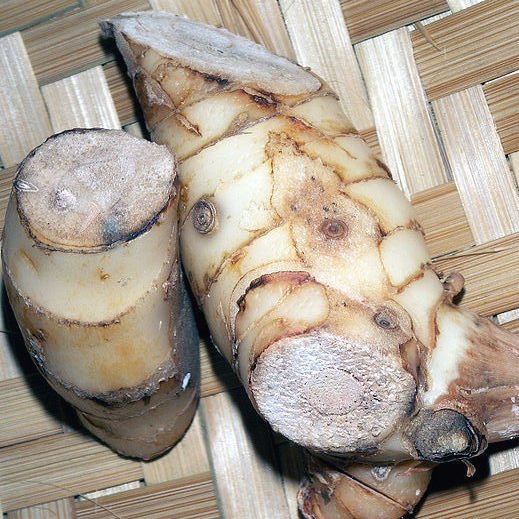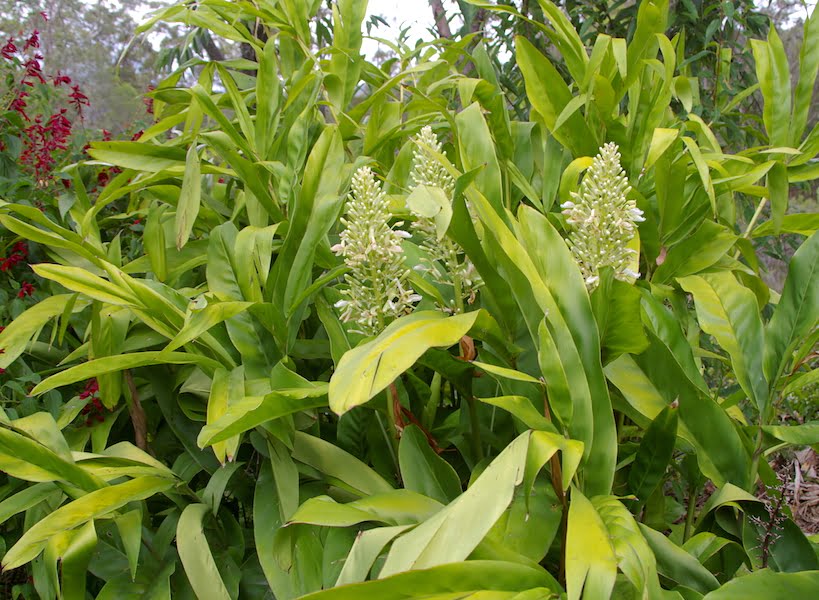If you’re like me and just can’t get enough Thai inspired cuisine at home, it’s time you considered growing more Asian herbs in your garden. Lots of people now grow coriander, Thai basil and chilli as a garden staple, but it’s time to consider another essential Asian herb – galangal (Alpinia galanga).
It may look like ginger and even be related, but don’t let its family ties fool you – it is pink in colour with a more peppery-citrus flavour. It can also be a little pithy so it needs to be chopped finely or even crushed for optimal flavour.
 Galangal is best planted in early spring by positioning small rhizomes with at least 1-2 buds about 20cm apart. Mark the area so you do not mistakenly destroy any rhizomes with a shovel when dormant. Try to plant them as understory plants where they will be protected from full sun and frost. Drought and frost sensitive, galangal does prefer tropical and sub-tropical conditions, but will grow well in warm temperate areas as long as they are protected from frost. In cooler areas you can always try growing them under a cloche. Galangal is relatively disease free; the only problem that may occur is root rot if the ground is too wet, even though they do prefer a moist soil.
Galangal is best planted in early spring by positioning small rhizomes with at least 1-2 buds about 20cm apart. Mark the area so you do not mistakenly destroy any rhizomes with a shovel when dormant. Try to plant them as understory plants where they will be protected from full sun and frost. Drought and frost sensitive, galangal does prefer tropical and sub-tropical conditions, but will grow well in warm temperate areas as long as they are protected from frost. In cooler areas you can always try growing them under a cloche. Galangal is relatively disease free; the only problem that may occur is root rot if the ground is too wet, even though they do prefer a moist soil.
Because galangal is a rhizome, the plants multiply in the soil, and it is these additional rhizomes that can be harvested. To harvest, carefully remove a few rhizomes from the side of the clump at a time rather than digging up the whole thing. This will allow the plant to keep producing for many years to come. It’s best to wait at least a year before beginning to harvest from new plants so that they can establish, but in only a few years’ time, you will be able to harvest whenever it is needed. If harvesting in large quantities or dividing plants for propagation, wait until the leaves have yellowed or died off in late autumn and winter.

Galangal Alpinia galanga Photo Arno King
Once harvested, galangal can be kept in the crisper section of the fridge for several weeks or if you need to store it for longer periods, it can be frozen or dried. Be sure to leave the skin on until use to preserve its freshness. Just wrap the roots in grease-proof paper and place in a zip-lock plastic bag in the fridge until you are ready to cook. If freezing, cut it into more convenient lengths and freeze in plastic. If dried, cut in slices and store in an airtight container. It can be easily rehydrated before use.
Now I grow things because of their flavour, but many people like to know what other health benefits you may gain. Being a part of the ginger family, galangal is said to be a cure for everything from motion sickness to impotence – so a little in your diet will go a long way!
Galangal is an important ingredient in most south-east Asian curries and dishes, especially Malaysian, Thai and Indonesian cuisine. A thin slither of fresh galangal is equivalent to about a teaspoon of dried galangal so use it with caution.
Below is a quick and easy Green Curry Paste recipe that will undoubtedly help to motivate you to order that very first rhizome. Bon appetit!
Green Curry Paste
Ingredients
15 birdseye chillies
10 cloves of garlic (chopped)
1 tsp chopped galangal
1 tblsp lemongrass (thinly sliced)
½ tsp lime zest
1 tsp cilantro/coriander root (chopped)
5 white pepper corns
1 tblsp coriander seeds (roasted)
1 tsp cumin seeds (roasted)
1 tsp shrimp paste (Kapi)
Fish sauce to taste
Method
Mix in a mortar and pestle or food processor until it forms a paste. Place in a sealed container in the fridge. Use as you would any store bought curry paste although this one is MSG and preservative free, as well as delicious. It will keep in the fridge for about a month.
